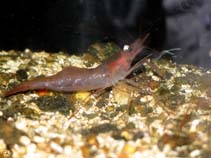Pandalus borealis Krøyer, 1838
Northern shrimp| Native range | All suitable habitat | Point map | Year 2050 |

|
| This map was computer-generated and has not yet been reviewed. |
| Pandalus borealis AquaMaps Data sources: GBIF OBIS |
Classification / Names Common names | Synonyms | CoL | ITIS | WoRMS
Malacostraca | Decapoda | Pandalidae
Environment: milieu / climate zone / depth range / distribution range Ecology
Benthopelagic; depth range 9 - 1450 m (Ref. 85480), usually 50 - 500 m (Ref. 85480). Boreal; -2°C - 12°C (Ref. 85480), preferred 4°C (Ref. 107945); 82°N - 35°N, 180°E - 180°E (Ref. 85480)
Distribution Countries | FAO areas | Ecosystems | Occurrences | Introductions
Circumpolar. Temperate to polar.
Length at first maturity / Size / Weight / Age
Maturity: Lm 2.4, range 2 - 2.443 cm Max length : 12.0 cm TL male/unsexed; (Ref. 8); 16.5 cm TL (female)
Short description Morphology
Life cycle and mating behavior Maturity | Reproduction | Spawning | Eggs | Fecundity | Larvae
Main reference
References | Coordinator | Collaborators
Piepenburg, D., N.V. Chernova, C.F. von Dorrien, J. Gutt, A.V. Neyelov, E. Rachor, L. Saldanha and M.K. Schmid 1996 Megabenthic communities in the waters around Svalbard. Polar Biol. 16:431-446. (Ref. 2952)
IUCN Red List Status
(Ref. 130435: Version 2025-1)
CITES status (Ref. 108899)
CMS (Ref. 116361)
Threat to humans
Human uses
Fisheries: commercial
FAO - Fisheries: landings, species profile | FIRMS (Stock assessments) | FishSource | Sea Around Us
Tools
More information
Max. ages / sizes
Length-weight rel.
Length-length rel.
Length-frequencies
Mass conversion
Abundance
Internet sources
BHL | BOLD Systems | CISTI | DiscoverLife | FAO(Fisheries: species profile; publication : search) | Fishipedia | GenBank (genome, nucleotide) | GloBI | Gomexsi | Google Books | Google Scholar | Google | PubMed | Tree of Life | Wikipedia (Go, Search) | Zoological Record



